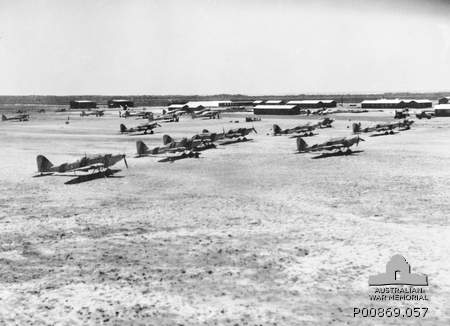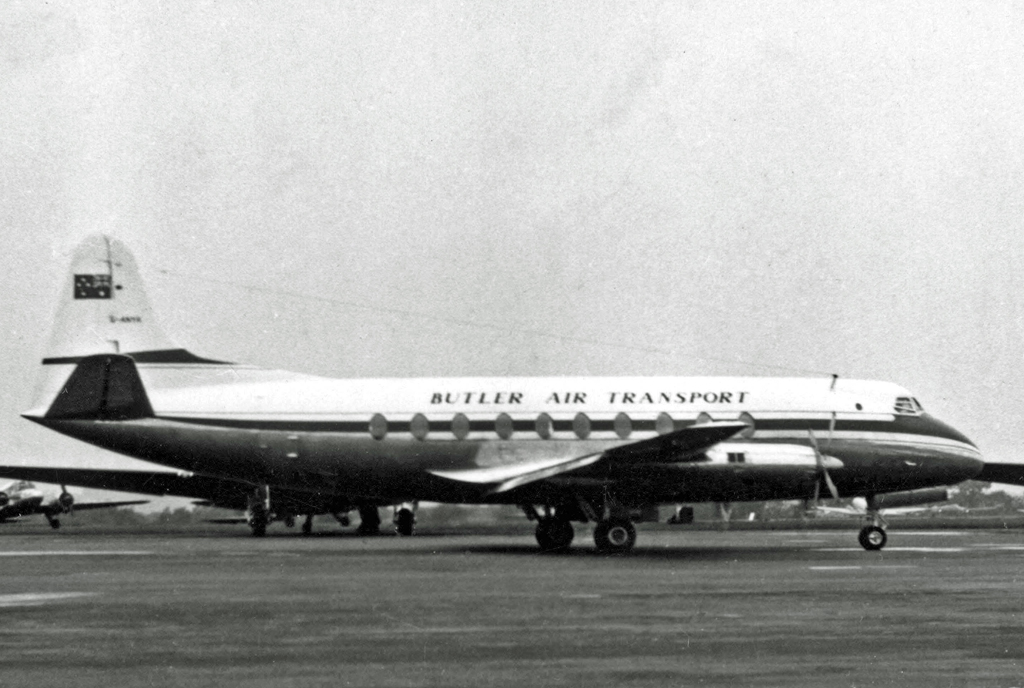|
Evans Head Memorial Aerodrome
Evans Head Memorial Aerodrome is a heritage-listed airport in Evans Head, Richmond Valley Council, New South Wales. The airport is approximately north of the village. During World War II it was Royal Australian Air Force (RAAF) Station Evans Head supporting RAAF No 1 Bombing and Gunnery School (1BAGS) and subsequently the RAAF No 1 Air Observers School. At the height of operations there were three asphalt runways and one grass strip. Only a single asphalt strip is still in use by private aviation. It was added to the New South Wales State Heritage Register on 22 November 2002. Richmond Valley Council with the assistance of the recently formed Evans Head Memorial Aerodrome Heritage Aviation Association (EHMAHAA) and Evans Head Air Park, has been actively supporting the restoration of a number of heritage items located on the aerodrome including the restoration of the last remaining Bellman hangar and the refurbishment and relocation of the original base canteen. The fully res ... [...More Info...] [...Related Items...] OR: [Wikipedia] [Google] [Baidu] |
Fairey Battle
The Fairey Battle is a British single-engine light bomber that was designed and manufactured by the Fairey Aviation Company. It was developed during the mid-1930s for the Royal Air Force (RAF) as a monoplane successor to the Hawker Hart and Hind biplanes. The Battle was powered by the same high-performance Rolls-Royce Merlin piston engine that powered various contemporary British fighters such as the Hawker Hurricane and Supermarine Spitfire. As the Battle, with its three-man crew and bomb load, was much heavier than the fighters, it was therefore much slower. Though a great improvement over the aircraft that preceded it, its relatively slow speed, limited range and inadequate defensive armament of only two .303 (7.7 mm) machine guns left it highly vulnerable to enemy fighters and anti-aircraft fire.Ethell 1995, p. 177. The Fairey Battle was used on operations early in the Second World War. During the "Phoney War" the type achieved the distinction of scoring the first aer ... [...More Info...] [...Related Items...] OR: [Wikipedia] [Google] [Baidu] |
Valston Hancock
Air Marshal Sir Valston Eldridge Hancock, (31 May 190729 September 1998) was a senior commander in the Royal Australian Air Force (RAAF). He served as Chief of the Air Staff from 1961 to 1965. A graduate of the Royal Military College, Duntroon, Hancock transferred from the Army to the RAAF in 1929 and qualified as a pilot. His administrative training at Duntroon saw him mainly occupy staff posts, including Deputy Director of Operations and Intelligence at RAAF Headquarters from 1931 to 1935, and Director of Works and Buildings from 1937 to 1939. During the early years of World WarII, he commanded No.1 Bombing and Gunnery School, and held senior planning and administrative positions. He eventually saw combat in the Aitape–Wewak campaign of the Pacific War during 1945. Flying Bristol Beaufort light bombers, he led first No.100 Squadron, and later No.71 Wing. His actions earned him the Distinguished Flying Cross. After the war, Hancock became the inaugural commandant of RA ... [...More Info...] [...Related Items...] OR: [Wikipedia] [Google] [Baidu] |
Butler Air Transport
Butler Air Transport was an Australian airline founded by C. Arthur Butler to operate air transport primarily among New South Wales airports in Australia, from 1934 until 1959.Butler, Cecil Arthur (1902–1980) , accessed 4 July 2011Butler Air Transport Co (1934–1959) Guide to Australian Business Records, accessed 4 July 2011 History [...More Info...] [...Related Items...] OR: [Wikipedia] [Google] [Baidu] |
Coraki Airfield
Coraki is a small town that sits on the confluence of the Richmond and Wilson Rivers in northern New South Wales, Australia in Richmond Valley Shire. At the 2016 census, Coraki had a population of 1,277 people. Material was copied from this source, which is available under Creative Commons Attribution 4.0 International License. History The name ''Coraki'' is derived from the Bundjalung word ''gurigay'', meaning ''the meeting of the waters'', and the Bundjalung people are the traditional owners of the area. The village was founded by William Yabsley in 1849 when Lismore was only a small cattle station and Casino had only one store and a hotel. Yabsley and his family obtained the lease to Brook Station and established the first permanent settlement. He built his shipyard just above ''The Junction'', as it was first called. Many ships and river boats were launched there and Yabsley opened a store for provisions for the cedar cutters who came to the district. Transport at the tim ... [...More Info...] [...Related Items...] OR: [Wikipedia] [Google] [Baidu] |
Wackett Trainer (AWM AC0154)
Sir Lawrence James Wackett (2 January 1896 – 18 March 1982) is widely regarded as "father of the Australian aircraft industry". He has been described as "one of the towering figures in the history of Australian aviation covering, as he did, virtually all aspects of activities: pilot, designer of airframes and engines, entrepreneur and manager". He was knighted for his services to aviation and was a winner of the Oswald Watt Gold Medal. He was also a keen angler and wrote two books on the subject. Early years, war service and education Wackett was born in Townsville, Queensland, on 2 January 1896. He joined the Australian Army and graduated from the Royal Military College, Duntroon, then with the rank of lieutenant joined No. 1 Squadron of the Australian Flying Corps (AFC) which had formed at Point Cook the day before his 20th birthday. He was one of twelve pilots that went to Egypt with the Squadron to operate in support of the Sinai and Palestine Campaign, embarking on 16 ... [...More Info...] [...Related Items...] OR: [Wikipedia] [Google] [Baidu] |
CAC Wackett
The CAC Wackett Trainer was the first aircraft type designed in-house by the Commonwealth Aircraft Corporation of Australia. The name was derived from its designer Lawrence Wackett. "In acknowledgement of the CAC Manager's enormous contribution, the RAAF were to call the aircraft the Wackett Trainer" (although often referred to as simply the Wackett) Development The type was designed to meet RAAF Specification 3/38 for an ''ab initio'' training aircraft. It was a tandem seat fixed tailwheel-undercarriage monoplane aircraft with a fuselage of steel tube and fabric construction and wings and tail made of wood. Despite the simplicity of the design, construction of the first of two CA-2 prototypes, begun in October 1938, was not completed until September 1939 (this was partly because CAC was still building its factory during this time period). The first prototype flew for the first time on 19 September 1939 fitted with a Gipsy Major series II engine, fitted with a metal DH variab ... [...More Info...] [...Related Items...] OR: [Wikipedia] [Google] [Baidu] |
Avro Anson
The Avro Anson is a British twin-engined, multi-role aircraft built by the aircraft manufacturer Avro. Large numbers of the type served in a variety of roles for the Royal Air Force (RAF), Fleet Air Arm (FAA), Royal Canadian Air Force (RCAF) and numerous other air forces before, during, and after the Second World War. Initially known as the ''Avro 652A'', the Anson was developed during the mid-1930s from the earlier Avro 652 airliner in response to a request for tenders issued by the British Air Ministry for a maritime reconnaissance aircraft. Having suitably impressed the Ministry, a single prototype was ordered, which conducted its maiden flight on 24 March 1935. Following an evaluation in which the Type 652A bettered the competing de Havilland DH.89, it was selected as the winner, leading to Air Ministry Specification 18/35 being written around the type and an initial order for 174 aircraft being ordered in July 1935. The Type 652A was promptly named after British Admira ... [...More Info...] [...Related Items...] OR: [Wikipedia] [Google] [Baidu] |
RAAF Station Cootamundra
Cootamundra Airport is a small airport in Cootamundra, New South Wales, Australia. The airport is also the venue for the annual GTR Challenge and Drag Battle motorsport event. History With the implementation of an airmail service between Australia and Britain, owing to its location on the Main Southern railway line midway between Sydney and Melbourne and proximity to Canberra, Cootamundra was chosen as the southern terminus. The airfield became the initial base for Butler Air Transport, established as an airmail contractor in 1934 to operate a section of the route between Cootamundra and Charleville, providing connection to Qantas services between Brisbane and Darwin. The company relocated its base to Sydney in 1938 following the withdrawal of the airmail contract. From 1991 to 2002 Country Connection Airlines offered regional flights from Cootamundra to Sydney, as well as to many other regional locations such as West Wyalong, Cowra, Forbes and Young. RAAF Station Cootamundr ... [...More Info...] [...Related Items...] OR: [Wikipedia] [Google] [Baidu] |
Chips Rafferty
John William Pilbean Goffage MBE (26 March 190927 May 1971), known professionally as Chips Rafferty, was an Australian actor. Called "the living symbol of the typical Australian", Rafferty's career stretched from the late 1930s until his death in 1971, and during this time he performed regularly in major Australian feature films as well as appearing in British and American productions, including '' The Overlanders'' and '' The Sundowners''. He appeared in commercials in Britain during the late 1950s, encouraging British emigration to Australia. Early days He was born John William Pilbean Goffage in Broken Hill, New South Wales to John Goffage, an English-born stock agent, and Australian-born Violet Maude Joyce.Pike, A. (1996) "Goffage, John William Pilbean hips Rafferty(1909–1971)", ''Australian Dictionary of Biography'', Volume 14, Melbourne University Press. Gaining the nickname "Chips" as a school boy, Rafferty studied at Parramatta Commercial School before working in a va ... [...More Info...] [...Related Items...] OR: [Wikipedia] [Google] [Baidu] |
Vickers Machine Gun
The Vickers machine gun or Vickers gun is a Water cooling, water-cooled .303 British (7.7 mm) machine gun produced by Vickers Limited, originally for the British Army. The gun was operated by a three-man crew but typically required more men to move and operate it: one fired, one fed the ammunition, the others helped to carry the weapon, its ammunition, and spare parts. It was in service from before the First World War until the 1960s, with air-cooled versions of it on many Allies of World War I, Allied World War I fighter aircraft. The weapon had a reputation for great solidity and reliability. Ian V. Hogg, in ''Weapons & War Machines'', describes an action that took place in August 1916, during which the British 100th Company of the Machine Gun Corps fired their ten Vickers guns to deliver sustained fire for twelve hours. Using 100 barrels, they fired a million rounds without breakdowns. "It was this absolute foolproof reliability which endeared the Vickers to every Britis ... [...More Info...] [...Related Items...] OR: [Wikipedia] [Google] [Baidu] |
303 British
The .303 British (designated as the 303 British by the C.I.P. and SAAMI) or 7.7×56mmR, is a calibre rimmed rifle cartridge. The .303 inch bore diameter is measured between rifling lands as is the common practice in Europe which follows the traditional black powder convention. It was first manufactured in Britain as a stop-gap black powder round put into service in December 1888 for the Lee–Metford rifle. From 1891 the cartridge used smokeless powder which had been the intention from the outset, but the decision on which smokeless powder to adopt had been delayed. It was the standard British and Commonwealth military cartridge for rifles and machine guns from 1889 until the 1950s when it was replaced by the 7.62×51mm NATO. Cartridge specifications The .303 British has 3.64 ml (56 grains H2O) cartridge case capacity. The pronounced tapering exterior shape of the case was designed to promote reliable case feeding and extraction in bolt-action rifles and machine guns a ... [...More Info...] [...Related Items...] OR: [Wikipedia] [Google] [Baidu] |







.jpg)
